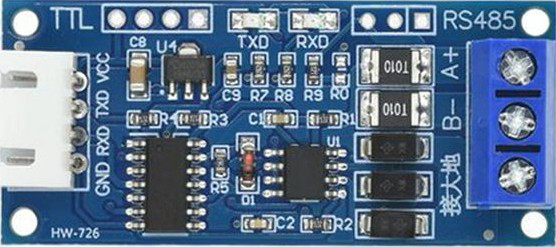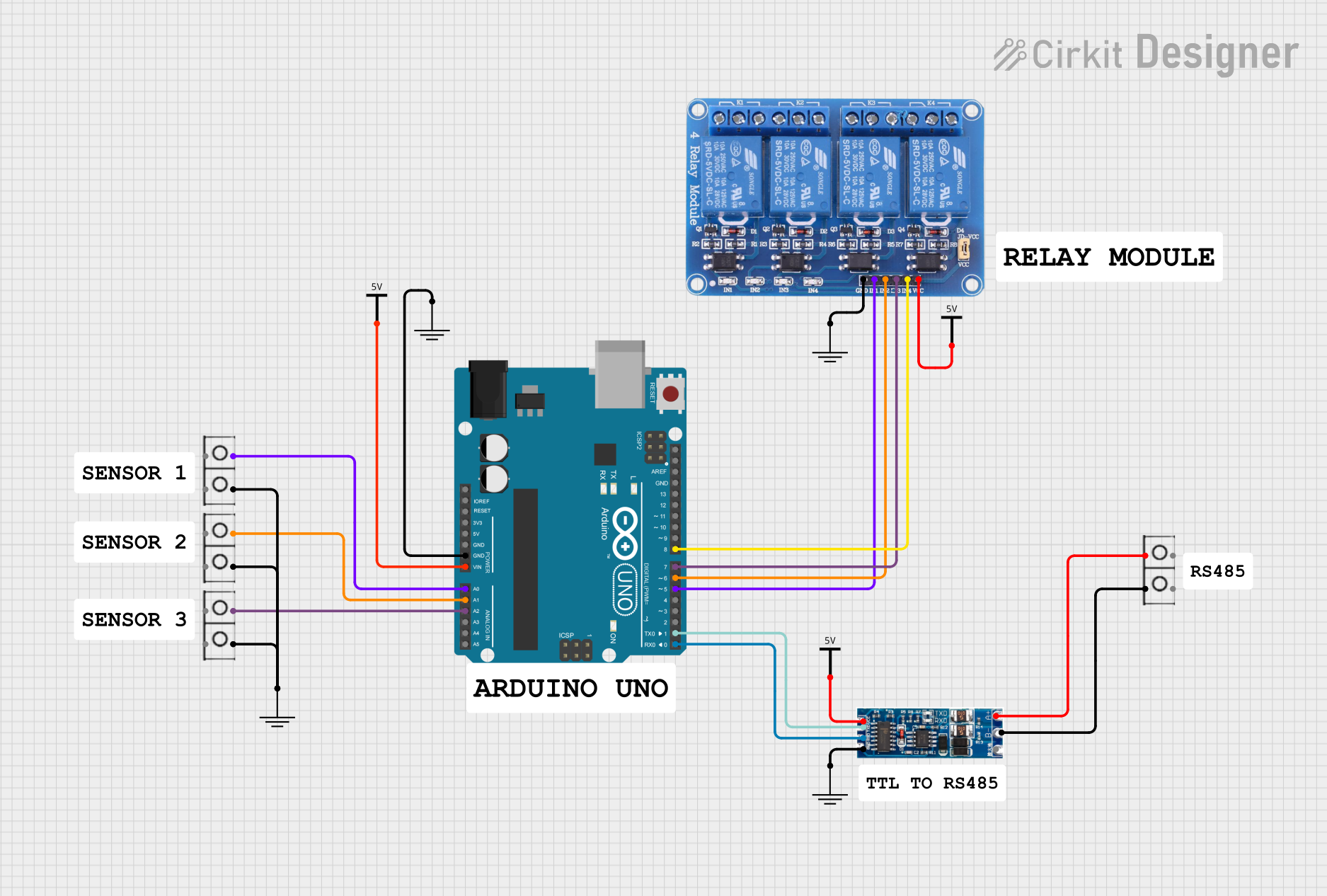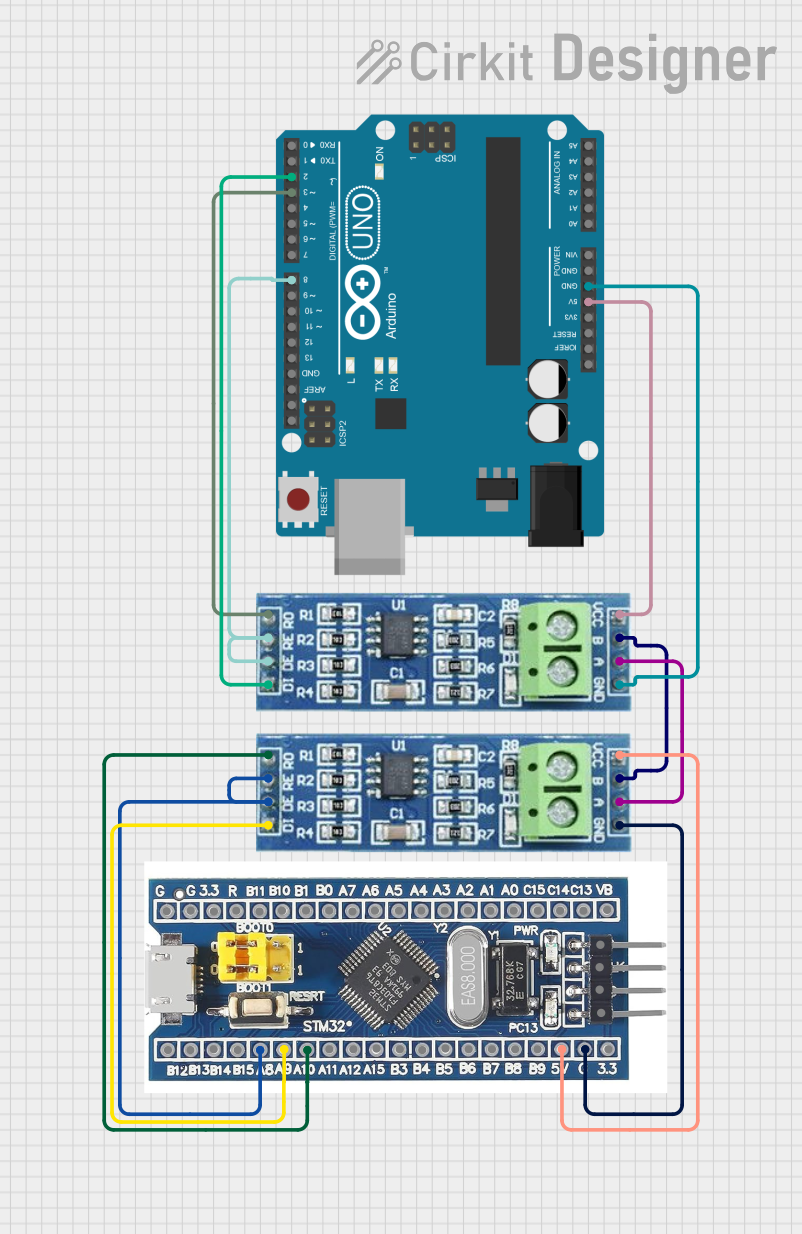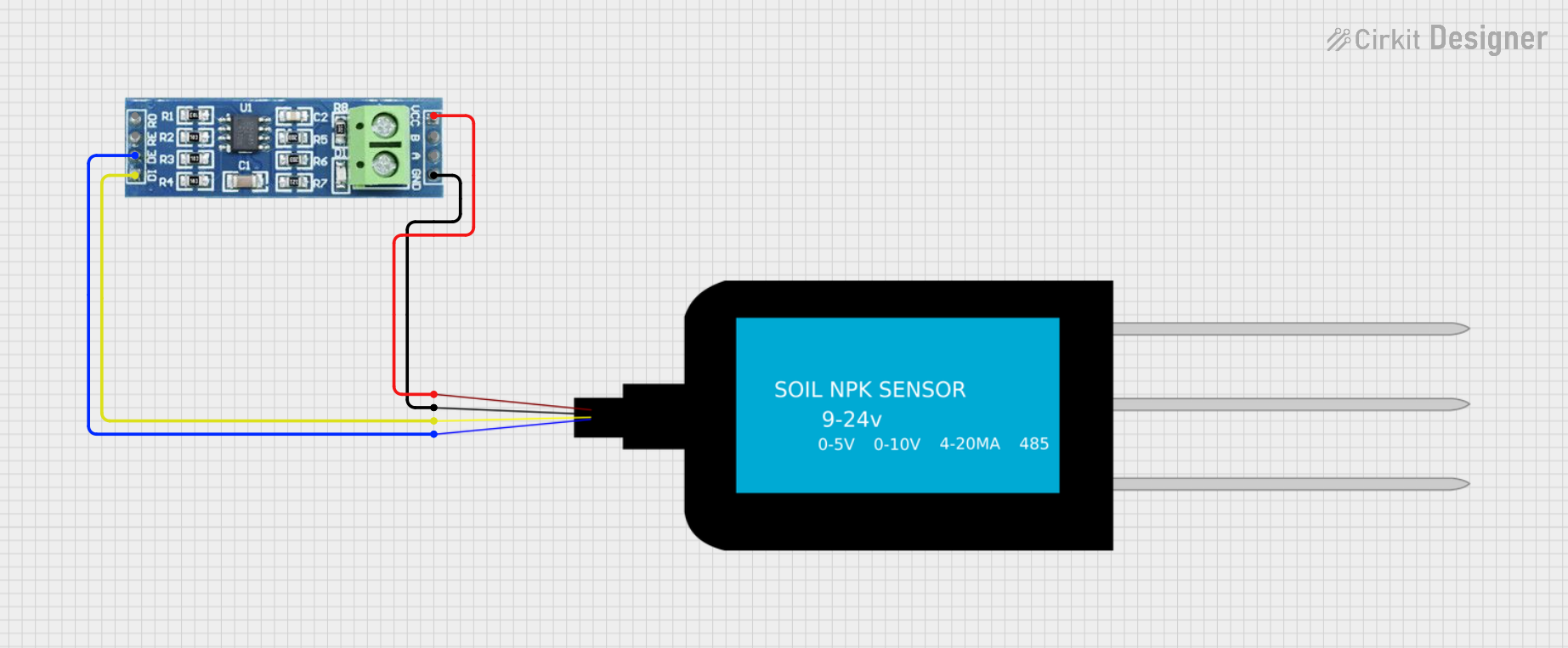
How to Use RS485 to TTL Isolated: Examples, Pinouts, and Specs

 Design with RS485 to TTL Isolated in Cirkit Designer
Design with RS485 to TTL Isolated in Cirkit DesignerIntroduction
The RS485 to TTL Isolated converter is a versatile electronic component designed to facilitate communication between RS485 and TTL devices. It provides electrical isolation, which is crucial for protecting sensitive circuits from voltage spikes, ground loops, and other electrical disturbances. This isolation ensures reliable data transmission in industrial, automotive, and embedded systems.
Explore Projects Built with RS485 to TTL Isolated

 Open Project in Cirkit Designer
Open Project in Cirkit Designer
 Open Project in Cirkit Designer
Open Project in Cirkit Designer
 Open Project in Cirkit Designer
Open Project in Cirkit Designer
 Open Project in Cirkit Designer
Open Project in Cirkit DesignerExplore Projects Built with RS485 to TTL Isolated

 Open Project in Cirkit Designer
Open Project in Cirkit Designer
 Open Project in Cirkit Designer
Open Project in Cirkit Designer
 Open Project in Cirkit Designer
Open Project in Cirkit Designer
 Open Project in Cirkit Designer
Open Project in Cirkit DesignerCommon Applications and Use Cases
- Industrial automation and control systems
- Communication between microcontrollers and RS485 devices
- Long-distance data transmission in noisy environments
- Protection of sensitive circuits in harsh electrical conditions
- Integration of RS485-based sensors and actuators with TTL-based microcontrollers
Technical Specifications
Key Technical Details
- Input Voltage (VCC): 3.3V to 5V DC
- RS485 Communication Standard: Half-duplex
- TTL Logic Levels: Compatible with 3.3V and 5V systems
- Isolation Voltage: Up to 2500V
- Baud Rate: Up to 115200 bps
- Operating Temperature Range: -40°C to 85°C
- Dimensions: Typically compact, varies by manufacturer
Pin Configuration and Descriptions
The RS485 to TTL Isolated module typically has the following pinout:
| Pin Name | Direction | Description |
|---|---|---|
| VCC | Input | Power supply input (3.3V to 5V DC). |
| GND | - | Ground connection. |
| TXD | Input | TTL transmit data (from microcontroller to RS485). |
| RXD | Output | TTL receive data (from RS485 to microcontroller). |
| A (D+) | Bidirectional | RS485 differential signal positive (D+). |
| B (D-) | Bidirectional | RS485 differential signal negative (D-). |
| ISO GND | - | Isolated ground for RS485 side. |
Note: Pin names and configurations may vary slightly depending on the manufacturer. Always refer to the specific datasheet for your module.
Usage Instructions
How to Use the Component in a Circuit
Power the Module:
- Connect the VCC pin to a 3.3V or 5V power source, depending on your system.
- Connect the GND pin to the ground of your microcontroller or power supply.
Connect TTL Signals:
- Connect the TXD pin of the module to the RX pin of your microcontroller.
- Connect the RXD pin of the module to the TX pin of your microcontroller.
Connect RS485 Signals:
- Connect the A (D+) and B (D-) pins to the RS485 bus.
- Ensure proper termination resistors (typically 120Ω) are used at both ends of the RS485 bus for reliable communication.
Isolation:
- Use the ISO GND pin for the RS485 side to maintain electrical isolation between the TTL and RS485 circuits.
Configure Communication:
- Set the baud rate and communication parameters (e.g., parity, stop bits) in your microcontroller to match the RS485 device.
Important Considerations and Best Practices
- Isolation: Ensure that the ground connections of the TTL and RS485 sides remain isolated to prevent ground loops.
- Termination Resistors: Use appropriate termination resistors to minimize signal reflections on the RS485 bus.
- Baud Rate Matching: Ensure the baud rate of the RS485 device matches the microcontroller's UART settings.
- Cable Length: RS485 supports long-distance communication, but ensure the cable length and quality are suitable for your baud rate.
Example Code for Arduino UNO
Below is an example of how to use the RS485 to TTL Isolated module with an Arduino UNO:
// Example: RS485 to TTL communication with Arduino UNO
// This code sends and receives data over RS485 using the RS485 to TTL module.
#include <SoftwareSerial.h>
// Define RX and TX pins for SoftwareSerial
#define RS485_RX 10 // Connect to RXD pin of the module
#define RS485_TX 11 // Connect to TXD pin of the module
// Create a SoftwareSerial object
SoftwareSerial RS485Serial(RS485_RX, RS485_TX);
void setup() {
// Initialize serial communication
Serial.begin(9600); // For debugging via Serial Monitor
RS485Serial.begin(9600); // For RS485 communication
Serial.println("RS485 to TTL Isolated Module Test");
}
void loop() {
// Send data over RS485
RS485Serial.println("Hello RS485!");
// Check if data is available from RS485
if (RS485Serial.available()) {
String receivedData = RS485Serial.readString();
Serial.print("Received: ");
Serial.println(receivedData); // Print received data to Serial Monitor
}
delay(1000); // Wait 1 second before sending the next message
}
Note: Replace
RS485_RXandRS485_TXwith the appropriate pins if using a different microcontroller.
Troubleshooting and FAQs
Common Issues and Solutions
No Data Transmission:
- Verify the connections between the module and the microcontroller.
- Ensure the baud rate and communication settings match between devices.
Data Corruption:
- Check for proper termination resistors on the RS485 bus.
- Ensure the cable length and quality are suitable for the baud rate.
Ground Loop Issues:
- Ensure the TTL and RS485 sides are electrically isolated.
- Use the ISO GND pin for the RS485 side.
Module Not Powering On:
- Verify the input voltage is within the specified range (3.3V to 5V).
- Check for loose or incorrect connections.
FAQs
Q: Can I use this module with a 3.3V microcontroller?
A: Yes, the module is compatible with both 3.3V and 5V logic levels.Q: What is the maximum communication distance for RS485?
A: RS485 supports distances up to 1200 meters, but this depends on the baud rate and cable quality.Q: Do I need to use termination resistors?
A: Yes, termination resistors (typically 120Ω) are recommended at both ends of the RS485 bus to ensure reliable communication.Q: Can I connect multiple devices to the RS485 bus?
A: Yes, RS485 supports multi-drop communication with up to 32 devices on the same bus.
By following this documentation, you can effectively integrate the RS485 to TTL Isolated module into your projects for robust and reliable communication.